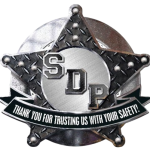You know those cool keychains that do more than just hold your keys? They're actually pretty amazing little tools that can help keep you safe while you're out and about. Think of them as your pocket-sized bodyguards! From kubotan sticks (fancy name for a small defensive stick) to bright tactical flashlights and personal alarms that could wake up the whole neighborhood, these gadgets clip right onto your everyday keys.
The neat thing about these tools is how they're designed to be both practical and protective. Some have quick-release clips that work faster than you can say "safety first," and others have glow-in-the-dark parts that light up like tiny beacons when you're fumbling for your keys at night. It's kind of like having a Swiss Army knife, but for personal safety!
Before you get too excited about carrying one of these around, though, you'll want to check what's allowed in your area. The rules can be pretty different depending on where you live – what's totally fine in one city might be a no-go in another. It's like learning the local traffic rules, but for safety tools.
And here's the thing about using these tools effectively – it's all about practice, practice, practice! Just like learning to ride a bike, you need to build up that muscle memory so using them becomes second nature. Once you understand all the different options out there (and there are quite a few!), you can pick the perfect one that fits your style and needs. After all, the best self-defense tool is the one you're comfortable carrying and know how to use!
Types of Self Defense Keychains
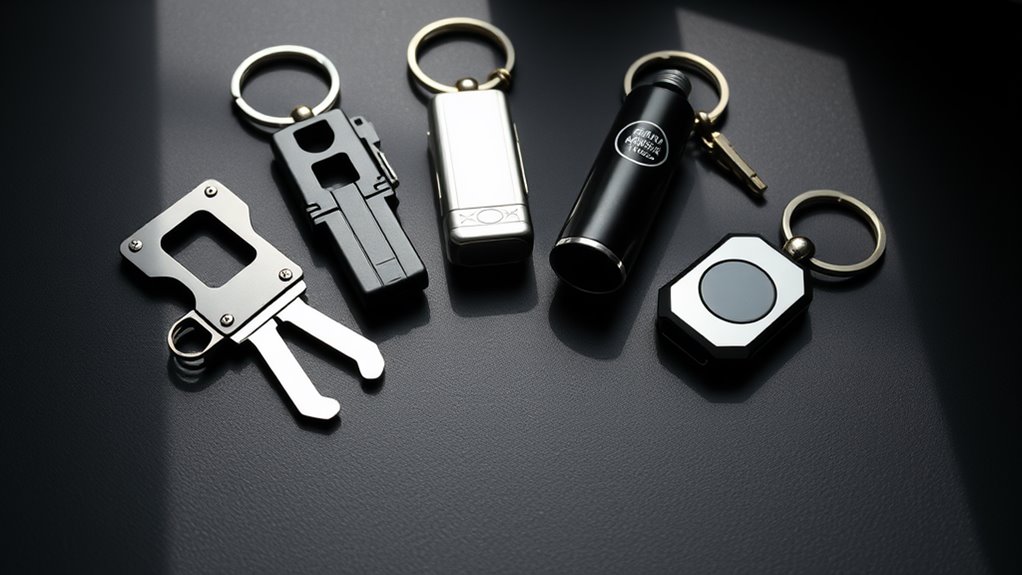
Let's talk self-defense keychains – because honestly, who doesn't want to feel like a ninja while carrying their house keys?
The options are pretty wild:
- Kubotan sticks (fancy name for "metal stick that means business")
- Cat-shaped weapons (cute AND dangerous – my kind of combo!)
- Tactical flashlights (blind 'em and bonk 'em)
- Personal alarms (scream like a banshee at 130 decibels)
I'm particularly fond of those cat-shaped ones. Nothing says "don't mess with me" like metal kitty ears that can take down an attacker. The Cat Strike Self-Defense Keychain is made from ultra-tough polymer plastic, offering durability and reliability in critical situations.
And let's be real – they look adorable on your keyring.
Pepper spray keychains are fantastic too, especially when you need to keep your distance from creeps.
Because sometimes, the best self-defense is making sure nobody can get close enough to try anything stupid.
Pro tip: Get a brightly colored keychain – it's easier to grab in your bag during emergencies, plus attackers won't expect serious self-defense gear to come in hot pink.
For those who prefer a blend of style and functionality, the Brutus Self Defense Key Chain offers a durable and compact option that is easily attachable to key rings.
Legal Considerations When Carrying Tools
Listen up, because this stuff is seriously important. The legal maze around carrying self-defense tools is wild, and you definitely don't want to end up on the wrong side of it.
Quick reality check:
- What's totally fine in Texas might get you arrested in California
- Your "harmless" kubotan? Illegal weapon in some places
- That pepper spray you bought at the mall? Might need a permit
The Mace Police Model Pepper Spray is 100% TSA/FAA compliant, making it a convenient option for travel, but always ensure compliance with local regulations.
I know, I know – it's frustrating that we can't just carry whatever makes us feel safe. Welcome to the wonderful world of varying state laws! (Eye roll.)
Look, do yourself a favor and research your local regulations. And don't pull that "but the store was selling it!" excuse – that won't fly with law enforcement, trust me.
Take five minutes to:
- Check state laws
- Look up city ordinances
- Call local police if you're unsure
Pro tip: Save your local police department's non-emergency number in your phone – they're usually happy to answer questions about what's legal to carry, and it's way better than learning the hard way.
The durable construction of a kubotan offers long-lasting use, making it a popular choice for personal safety despite the complex legal considerations.
Choose Your Best Defense Tool
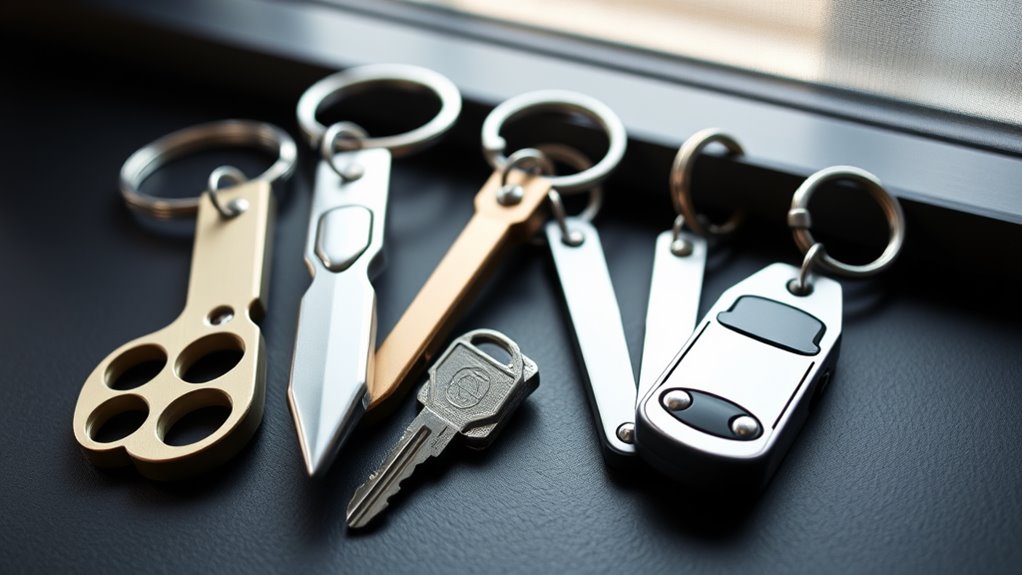
Let's talk self-defense tools, because honestly, who doesn't want to feel safe these days?
Listen up – choosing protection isn't rocket science, but it matters. A lot. Think about what feels right for you, not what your neighbor Dave swears by (sorry, Dave).
Your options:
- Pepper spray (the spicy way to say "back off")
- Personal alarms (for when you need to wake up the whole neighborhood)
- Impact tools (for the martial arts wannabe in you)
Real talk: the "best" tool is whatever you'll actually carry and use. Period. No point having a fancy kubaton if it's gathering dust in your drawer, right?
Pick something that matches your vibe. Can't handle sprays? Cool, go with sound. Want something simple? Perfect, grab an alarm. Just make sure you practice with it – because fumbling around during an emergency? Not cute.
Pro tip: Test your chosen tool in your backyard first – nothing builds confidence like muscle memory, and nothing's more awkward than accidentally pepper-spraying yourself in public.
Safety Features and Mechanisms
Safety features are your best friend when it comes to self-defense keychains – and trust me, you'll want them!
Let's break down what makes these little lifesavers so practical:
- Twist-lock systems (because nobody wants pepper spray going off in their pocket, right?)
- Protective caps that actually stay put
- Quick-release clips for those "oh crud" moments
- Glow-in-the-dark markers (because fumbling in the dark is so last year)
The best part? These aren't your grandma's keychains. Modern designs are seriously fool-proof, which is perfect for those of us who occasionally forget which end is which.
And don't even get me started on those fancy built-in alarms – they're like having a tiny bodyguard attached to your keys!
Pro tip: Always test your keychain's safety features in a safe space first, and make it a habit to check the mechanisms monthly – you'll thank me later when you're not explaining to your boss why your bag smells like pepper spray.
Training and Proper Usage
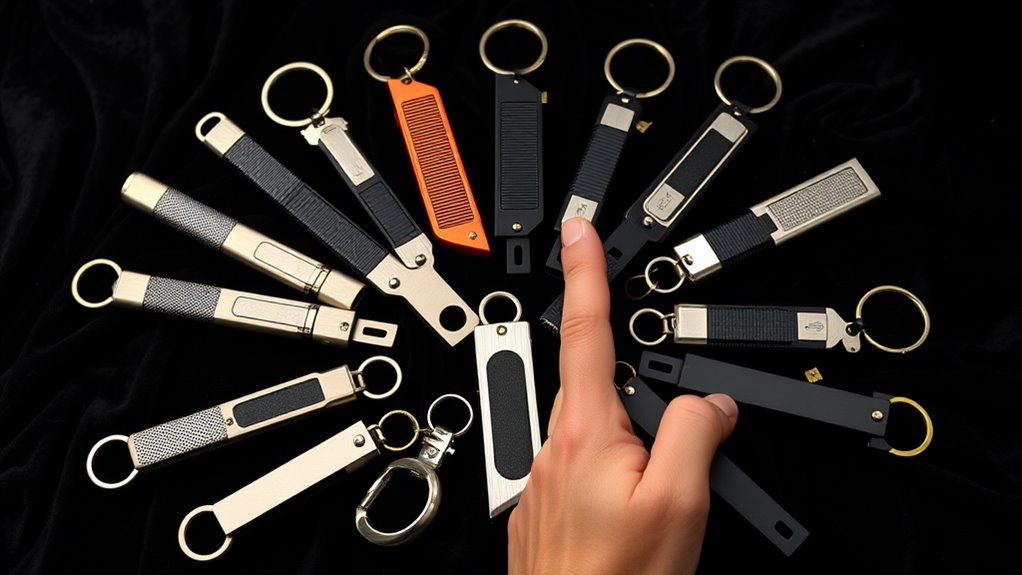
Let's get real about training – because having fancy self-defense gear means nothing if you can't use it properly!
Quick tips for mastering your keychain defense:
- Grip it like you mean it, but don't strangle it
- Practice grabbing it from different positions (yes, even while juggling your grocery bags)
- Build that muscle memory – your brain might freeze, but your hands shouldn't
Look, I get it. Training isn't exactly Netflix-and-chill exciting. But neither is being caught unprepared in a sketchy situation. Take a proper self-defense class – and no, watching YouTube tutorials doesn't count!
For real though, practice makes perfect. Whether you've got a kubaton or an alarm, knowing your tool inside and out is crucial. Think of it as learning to dance – awkward at first, but eventually, you'll nail those moves.
Pro tip: Keep your keychain accessible but not visible – attackers can't target what they can't see, and the element of surprise is your best friend.
Materials and Durability Standards
Let's talk about what really matters in self-defense keychains – because nobody wants their protection to fail when things get real!
Quality is everything, folks. I mean, seriously – would you trust your safety to some flimsy dollar store knockoff? (I didn't think so.)
What you want:
- Aircraft-grade aluminum – the good stuff
- Hardened steel that means business
- Impact-resistant polymers that can take a beating
The best manufacturers actually test their products – imagine that! They drop them, crush them, and basically try to destroy them so you don't have to find out the hard way that your keychain isn't up to snuff.
Skip those sketchy cheap options. You know the ones – they look legit online but arrive looking like they were made in someone's garage. Not exactly confidence-inspiring when your safety's on the line.
Pro tip: Keep an eye out for that sweet spot where durability meets weight – if it feels too light to be legitimate or too heavy to carry daily, keep shopping.
Concealment and Accessibility Tips
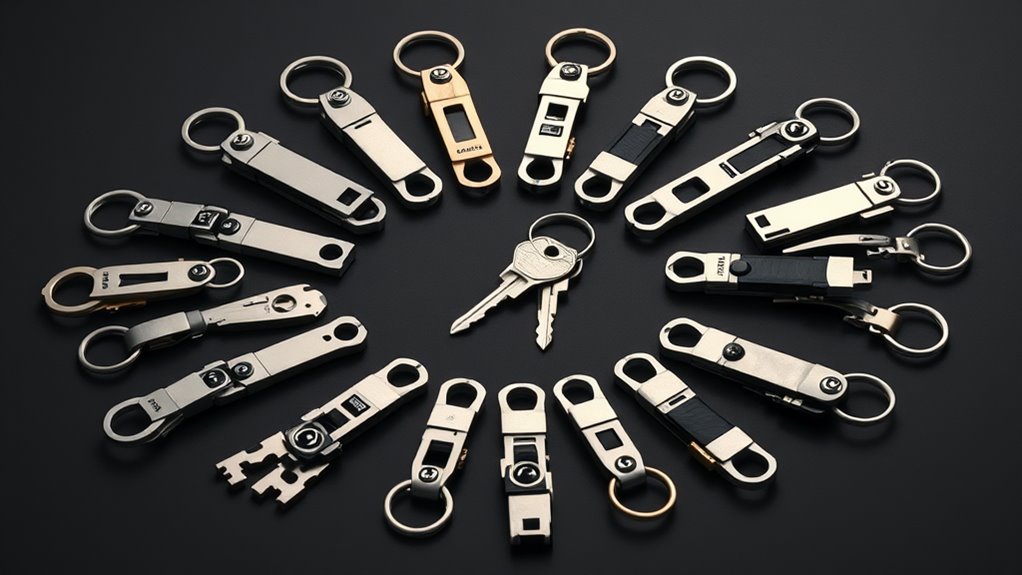
Let's talk about keeping your self-defense keychain ready for action – because what good is it if you can't grab it when you need it?
Quick access is everything, folks. Seriously.
- Hook it to your belt loop (you know, that thing holding up your pants)
- Clip it to your bag strap
- Just don't bury it in that bottomless pit you call a purse!
I can't tell you how many times I've seen people fumbling around for their keychains like they're searching for buried treasure. Not exactly helpful in a pinch, right?
Get yourself a retractable holder – they're basically like a yo-yo for grown-ups, but way more practical.
Make it look natural, like it belongs with your other everyday stuff. And please, for the love of everything, practice grabbing it. Nobody wants to see you doing the awkward fumble dance when it matters.
Pro tip: Test your keychain placement by timing yourself – if it takes longer than two seconds to grab, rethink your setup.
Real World Defense Scenarios
Let's get real about self-defense – it's nothing like those perfectly choreographed training videos. Urban survival is messy, chaotic, and totally unpredictable.
Split-second decisions. No do-overs. No time to dig through your purse like you're searching for lip balm at the bottom of the universe.
Key points for staying street-smart:
- Keep those keys ready when walking to your car (seriously, don't wait until you're at the door)
- Public transit? Your safety tool should be like your favorite snack – easily accessible
- Practice your moves! Because fumbling around during an actual crisis? Not cute.
Most attacks happen in the most mundane places – parking lots, elevators, or that sketchy corner by your building's entrance.
Kind of ruins the whole "I'll just quickly grab coffee" vibe, right?
Pro tip: The best self-defense move is being annoyingly aware of your surroundings – channel your inner meerkat and keep those eyes scanning like you're hunting for the last pizza slice at a party.
Frequently Asked Questions
Can Self-Defense Keychains Be Taken Through Airport Security Checkpoints?
You know those handy self-defense keychains you might carry around town? Well, they're a no-go at airport security, which is kind of a bummer if you're used to having that little confidence boost in your pocket. Think of airport security like your super-cautious friend who won't even let you bring pointy pencils to their house – they're pretty strict about these things! If you try to bring your trusty keychain through security, they'll probably spot it faster than a kid finding candy in a grocery store, and nobody wants to see their favorite safety tool end up in the airport's collection of confiscated items.
The good news is, you've got options! Just toss that keychain in your checked baggage, where it can hang out safely with your shampoo bottles and other things security gets nervous about. It's like sending your protective buddy on a different route to meet you at your destination. If you're not checking any bags, though, you might want to leave your keychain buddy at home – better safe than sorry, right? After all, getting held up at security explaining why you absolutely need your tactical keychain isn't exactly the fun part of traveling!
How Often Should Defensive Sprays and Electronic Devices Be Replaced?
Time really sneaks up on you with these things! Just like you check the milk in your fridge, you'll want to peek at your defensive spray's expiration date once a year – it's not something you want to discover has gone bad when you need it most. Think of it as giving your spray a little birthday check-up every year, and plan to swap it out every 2-3 years, kind of like how you replace your phone's case before it gets too worn out.
As for those electronic devices, they're a bit more patient with us. They'll hang in there for about 3-5 years, depending on how well the battery holds up and if they're still working like they should. It's kind of like your trusty old flashlight – you know it's time for a new one when it starts getting a bit sluggish or unreliable. After all, these are your personal safety buddies, so you want them to be ready to jump into action when you need them!
Do Self-Defense Keychains Work Effectively Against Multiple Attackers?
Self-defense keychains can help in a pinch, but let's be real – they're not exactly your superhero gadget when facing multiple attackers. Think of it like bringing a spoon to a food fight – sure, you've got something, but you'll need way more than that! Your best bet is to focus on smart strategies, like creating space between you and the attackers (kinda like playing a game of human pinball, minus the fun), and always knowing your escape routes.
When things get dicey with multiple threats, your keychain tool is more like a backup singer than the main act. The real star of the show is your situational awareness – you know, that little voice in your head that says "time to get out of here!" It's super important to have a game plan that includes looking for exits, staying alert, and being ready to move quickly, because relying on just one tool is like trying to open a whole toolbox with only a screwdriver.
The key here (pun totally intended!) is understanding that while these defensive tools can give you an edge, they work best as part of a bigger safety strategy. Think of it as having multiple layers of protection, just like wearing both a raincoat and carrying an umbrella during a storm – you're covering all your bases!
Are There Differences in Effectiveness Between Left-Handed and Right-Handed Defensive Tools?
Most defensive tools are pretty versatile and work great whether you're a lefty or righty, kind of like how a basketball works in both hands! Sure, you'll notice quite a few tools come with right-handed grips – it's just one of those things manufacturers do, like how spiral notebooks always seem designed for righties. But here's the good news: if you're left-handed, you've got options that'll feel as natural as writing with your dominant hand.
When you're shopping around, keep an eye out for those specifically designed left-handed versions. It's like finding a comfy pair of shoes that just fits perfectly – you know it's right when you hold it. Having a tool that feels natural in your hand isn't just about comfort, though. In those moments when you need to react quickly (you know, those "oh boy" situations), you'll want your defensive tool to feel like an extension of your arm, not like you're trying to use chopsticks for the first time!
Think of it this way: you wouldn't wear your shoes on the wrong feet, right? Same idea with defensive tools – getting one that matches your hand preference helps ensure you're ready for whatever comes your way, smooth as butter.
What's the Average Reaction Time Needed to Deploy a Keychain Defense Tool?
When it comes to reaction time with keychain defense tools, think of it like reaching for your phone when it starts ringing – you're looking at about 1-2 seconds to get it right. Just like learning to catch a ball or ride a bike, your reflexes get sharper the more you practice with your tool. It's kind of like having a trusty sidekick that needs to learn your moves, you know?
The cool thing is, once you get the hang of it, your brain starts to work like a well-oiled machine. You'll find yourself smoothly pulling out your keychain tool without even thinking about it, sort of like how you automatically reach for your car keys when you're heading out the door. With some solid practice time under your belt, you might even surprise yourself with how quickly you can spring into action.
Remember though, it's not just about being fast – it's about being smart-fast, if that makes sense. Getting your keychain defense tool ready in a hurry is great, but doing it right is what really counts. Think of it as learning a dance move – at first, you might stumble a bit, but pretty soon you'll be hitting all the right steps without missing a beat!



